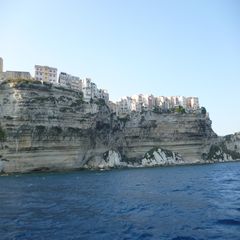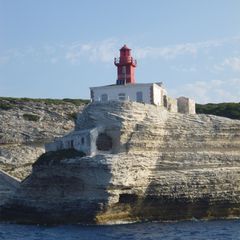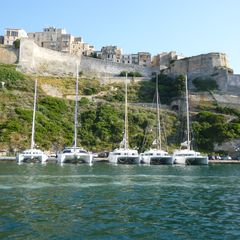
'Corsican Odyssey'
 Bonifacio famous cliffs
Bonifacio famous cliffs
 Bonifacio's red Madonetta lighthouse
Bonifacio's red Madonetta lighthouse
 Bonifacio's Harbour
Bonifacio's Harbour
The Sunday Age M Travel 20 May 2012
I may not be sailing home from a long and brutal Trojan war. Or be the King of Ithaca. But like Ulysses in Homer's epic poem The Odyssey, when I see Bonifacio's skyscraping chalk cliffs from the water, I am impressed.
Historians interpreting Homer's Odyssey believe it was Bonifacio's natural harbour where Ulysses encountered the Laestrygonians. In the poem, this prehistoric tribe of savage giants not only pelted rocks from the cliffs and sank Ulysses' ships, but also speared his crew and ate them. Only Ulysses, anchored apart from his flotilla, escaped.
There is no such hostility today, though. Boarding a launch to sightsee the spectacular southern Corsican coastline, the captain greets us with an enthusiastic, "Bienvenue!"
Weaving past chic ocean-going yachts, the launch squeezes through Homer's "harbour's jaws" - two bold headlands overlooking the Strait of Bonifacio. On one are the windswept graves of the marine cemetery; on the other, the Madonetta lighthouse. The combination of white cliffs, blue sea and the red Madonetta reminds me of the tri-colour flag of France - Corsica's ruler. Emerging from the narrow channel into open sea, I juggle my camera and a copy of The Odyssey. Its description fits:
We cruise the turquoise coves of Fazzio Bay, then double back to see the postcard favourite, Grain de Sable, a massive chunk of limestone shaven off into the sea. The precipitous cliffs are honeycombed with caves and Napoleon's Hat grotto fascinates with its strange stone stalactites dripping downwards like candle wax.
Bonifacio's famous King of Aragon stairway, Escalier du Roi d'Aragon, comes into view as we skirt the sea routes of old. Legend says these 187 steps, sculpted into the cliff-face, were hewn by King Alphonse's soldiers in a single night during the 1420 siege. The same urgency is lost on the nut-brown sunbakers sprawled across boulders at the base of the staircase.
The setting sun colours the chalk cliffs caramel, the blanched rock striated like wafers of mille-feuille pastry. Was this the rock-face Ulysses scaled to find a lookout? Above, the Haute Ville's ochre-roofed houses perch, washing flapping from balconies, a sharp drop of hundreds of metres to the indigo sea below.
The captain keeps up a commentary in French, pointing out a bastion watchtower here or a hilltop crucifix there, but the scenery needs no translation. I'm spellbound, in any language.
Returning to Homer's "flat calm" of the marina, the shelter the harbour affords is obvious, yet it's impossible not to imagine what an ideal trap it would have offered for ambushing unsuspecting ships in ancient times. As we dock, waiters at quayside bistros juggle cauldrons of mussels and bowls of frites. Diners sip pink champagne. Palms flutter in the warm Mediterranean dusk.
If Ulysses could see this now, surely he'd give Bonifacio a second chance.
© 2012 Kerrin O’Sullivan
With its white cliffs and blue waters, Bonifacio's tranquillity is the stuff of legend, writes Kerrin O'Sullivan
I may not be sailing home from a long and brutal Trojan war. Or be the King of Ithaca. But like Ulysses in Homer's epic poem The Odyssey, when I see Bonifacio's skyscraping chalk cliffs from the water, I am impressed.
Historians interpreting Homer's Odyssey believe it was Bonifacio's natural harbour where Ulysses encountered the Laestrygonians. In the poem, this prehistoric tribe of savage giants not only pelted rocks from the cliffs and sank Ulysses' ships, but also speared his crew and ate them. Only Ulysses, anchored apart from his flotilla, escaped.
There is no such hostility today, though. Boarding a launch to sightsee the spectacular southern Corsican coastline, the captain greets us with an enthusiastic, "Bienvenue!"
Weaving past chic ocean-going yachts, the launch squeezes through Homer's "harbour's jaws" - two bold headlands overlooking the Strait of Bonifacio. On one are the windswept graves of the marine cemetery; on the other, the Madonetta lighthouse. The combination of white cliffs, blue sea and the red Madonetta reminds me of the tri-colour flag of France - Corsica's ruler. Emerging from the narrow channel into open sea, I juggle my camera and a copy of The Odyssey. Its description fits:
"We entered a fine harbour there, all walled around
by a great unbroken sweep of sky-scraping cliff
and two steep headlands, fronting each other, close
around the mouth so the passage in is cramped."
Modern sightseeing begins in Sdragonato's (Little Dragon's) sea grotto. Above our heads, a crack in the cave's rocky dome reveals a gap of blue sky curiously resembling the map of Corsica. by a great unbroken sweep of sky-scraping cliff
and two steep headlands, fronting each other, close
around the mouth so the passage in is cramped."
We cruise the turquoise coves of Fazzio Bay, then double back to see the postcard favourite, Grain de Sable, a massive chunk of limestone shaven off into the sea. The precipitous cliffs are honeycombed with caves and Napoleon's Hat grotto fascinates with its strange stone stalactites dripping downwards like candle wax.
Bonifacio's famous King of Aragon stairway, Escalier du Roi d'Aragon, comes into view as we skirt the sea routes of old. Legend says these 187 steps, sculpted into the cliff-face, were hewn by King Alphonse's soldiers in a single night during the 1420 siege. The same urgency is lost on the nut-brown sunbakers sprawled across boulders at the base of the staircase.
The setting sun colours the chalk cliffs caramel, the blanched rock striated like wafers of mille-feuille pastry. Was this the rock-face Ulysses scaled to find a lookout? Above, the Haute Ville's ochre-roofed houses perch, washing flapping from balconies, a sharp drop of hundreds of metres to the indigo sea below.
The captain keeps up a commentary in French, pointing out a bastion watchtower here or a hilltop crucifix there, but the scenery needs no translation. I'm spellbound, in any language.
Returning to Homer's "flat calm" of the marina, the shelter the harbour affords is obvious, yet it's impossible not to imagine what an ideal trap it would have offered for ambushing unsuspecting ships in ancient times. As we dock, waiters at quayside bistros juggle cauldrons of mussels and bowls of frites. Diners sip pink champagne. Palms flutter in the warm Mediterranean dusk.
If Ulysses could see this now, surely he'd give Bonifacio a second chance.
© 2012 Kerrin O’Sullivan